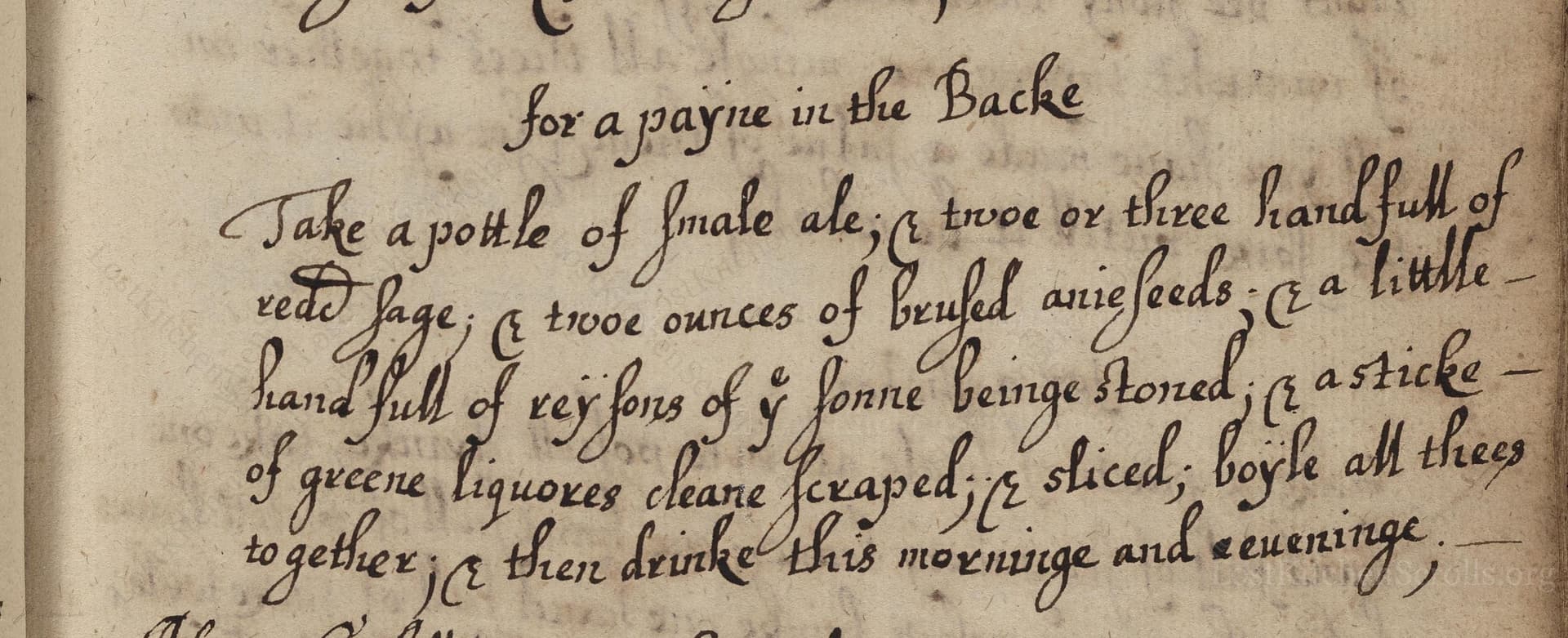For A Payne In The Backe
From the treasured pages of Receipt book of Margaret Baker
Written by Margaret Baker

For A Payne In The Backe
"Take a pottle of smale ale, & tvoe or three handfull of red sage, & tvoe ounces of brused anieseeds, & a little - handfull of reysons of ye sonne beinge stoned, & a sticke - of greene liquores cleane scraped, & sliced, boyle all thees together, & then drinke this morninge and eueninge;-"
Note on the Original Text
Seventeenth-century recipes such as this were written for those already familiar with basic techniques, so instructions are brief, quantities approximate, and spelling is variable ('payne' for pain, 'liquores' for liquorice, 'reysons' for raisins). The word 'pottle' refers to a liquid measure equivalent to about 2 quarts (1.1 liters). These records often mixed medical with culinary instruction, showing the blurred lines between food and remedy in early modern European households. The ritualistic consumption 'morninge and eueninge' reflects the period’s approach to dosing medicinal cordials.

Title
Receipt book of Margaret Baker (1675)
You can also click the book image above to peruse the original tome
Writer
Margaret Baker
Era
1675
Publisher
Unknown
Background
Step into the 17th-century kitchen with Margaret Baker, whose delectable recipes and culinary wisdom promise a feast of traditional flavors and genteel charms. A delightful collection for those who savor history as much as fine food.
Kindly made available by
Folger Shakespeare Library
This recipe hails from Margaret Baker’s collection, dated around 1675. During the 17th century in England, domestic recipe books were repositories of practical household knowledge, combining cookery, medicine, and household management. Remedies for common ailments often made use of ingredients from the kitchen and garden, reflecting the era’s blending of culinary and medicinal arts. Sage, anise, and liquorice were believed to possess warming and soothing qualities, making them popular in remedies for aches and pains. The use of ale demonstrates the limited distinction between drink and medicine, with alcohol acting as both solvent and fortifier in traditional English pharmacopoeia.

This remedy would have been prepared over an open hearth or charcoal brazier, using a large earthenware or metal pot for boiling. A wooden spoon or paddle would stir the mixture, and a linen cloth or sieve would strain out the solids before serving. Cups or small tankards—often made of pewter or pottery—would be used to consume the brew. Herbs and seeds might have been bruised with a mortar and pestle, and liquorice root scraped with a small kitchen knife.
Prep Time
10 mins
Cook Time
30 mins
Servings
4
We've done our best to adapt this historical recipe for modern kitchens, but some details may still need refinement. We warmly welcome feedback from fellow cooks and culinary historians — your insights support the entire community!
Ingredients
- 2 1/3 pints mild ale (or light beer as substitute)
- 1 ounce fresh red sage leaves (or common garden sage)
- 2 ounces aniseeds, bruised
- 1 1/2 ounces sun-dried raisins, pitted
- 1/3 ounce green liquorice root (dried liquorice stick if fresh unavailable)
Instructions
- To make this restorative brew for back pain, take 2 1/3 pints of mild ale (or a light beer as a substitute), and add two or three generous handfuls (around 1 ounce) of fresh red sage leaves.
- Next, crush about 2 ounces of aniseeds, and toss them in.
- Include a small handful (about 1 1/2 ounces) of 'raisins of the sun' — today’s sun-dried raisins with the stones removed.
- Finally, scrape clean and thinly slice a stick of green liquorice root (about 1/3 ounce; dried liquorice sticks are a suitable alternative).
- Combine everything in a large saucepan, bring it to a gentle boil, then simmer for about 20–30 minutes.
- Strain, and enjoy a cup in the morning and another in the evening, just as prescribed by our 17th-century forbearers.
Estimated Calories
90 per serving
Cooking Estimates
You will need some time to gather and prepare the ingredients, then you simmer everything for about 20–30 minutes. The whole recipe makes about 4 servings, and each cup has around 90 calories.
As noted above, we have made our best effort to translate and adapt this historical recipe for modern kitchens, taking into account ingredients nowadays, cooking techniques, measurements, and so on. However, historical recipes often contain assumptions that require interpretation.
We'd love for anyone to help improve these adaptations. Community contributions are highly welcome. If you have suggestions, corrections, or cooking tips based on your experience with this recipe, please share them below.
Join the Discussion
Rate This Recipe
Dietary Preference
Culinary Technique
Occasions

Den Bockfisch In Einer Fleisch Suppen Zu Kochen
This recipe hails from a German manuscript cookbook compiled in 1696, a time whe...

Die Grieß Nudlen Zumachen
This recipe comes from a rather mysterious manuscript cookbook, penned anonymous...

Ein Boudain
This recipe comes from an anonymous German-language manuscript cookbook from 169...

Ein Gesaltzen Citroni
This recipe, dating from 1696, comes from an extensive anonymous German cookbook...
Browse our complete collection of time-honored recipes



